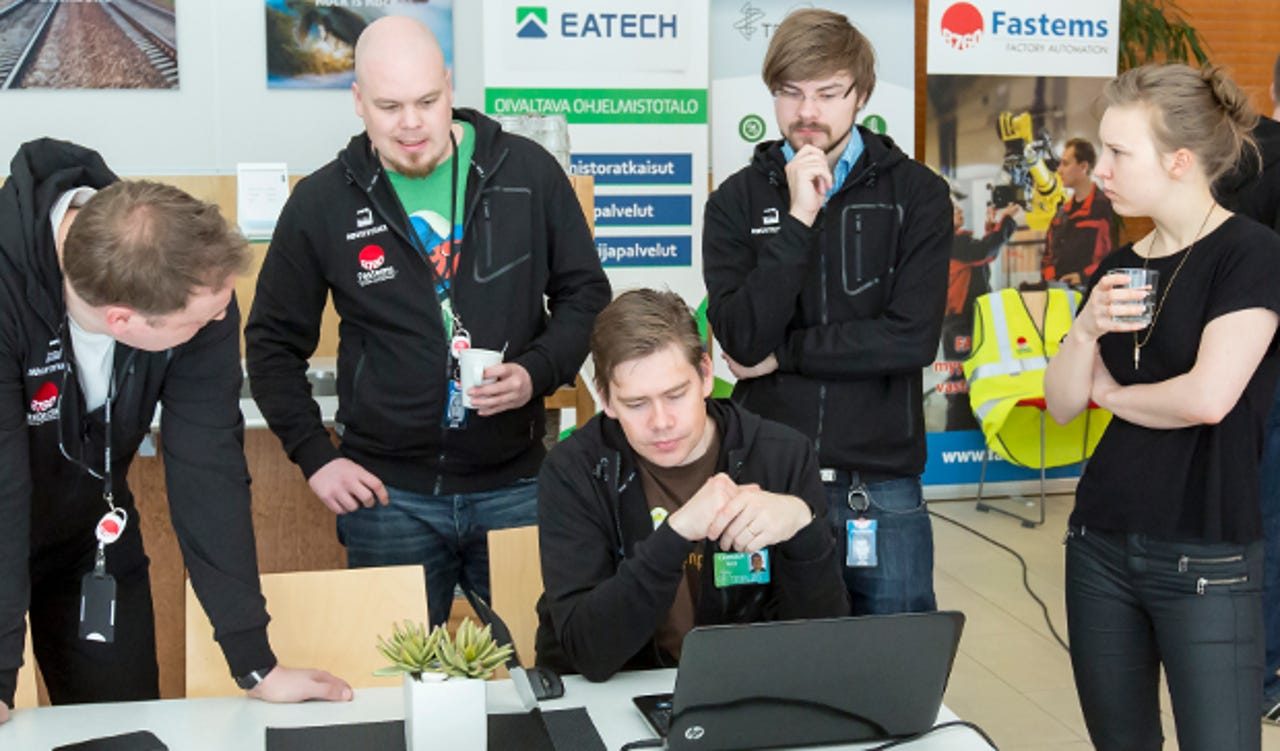Industrial IoT: From cranes to prototypes, how hackers are digging out new openings


Industry 4.0. Industrial internet. Industrial Internet of Things. Despite many names and endless hype, at its core the rapidly-expanding industrial Internet of Things (IIoT) refers to smart, connected, and industry-focused devices.
The potential this technology brings for new business models and efficiencies in manufacturing is remarkable. Accenture estimates IIoT could add as much as $14.2trn to the global economy by 2030 - and Finland is determined to grab these opportunities in new and innovative ways.
"There's a lot of talk and not enough action," says Ville Riikkala, co-founder of IndustryHack, a startup organising IIoT hackathons. "There are reports and seminars on what the Finnish industry should do to embrace the industrial internet. [But we] were started to create concrete IIoT experiments and learn what it really means for different industries."
IndustryHack does this through a shakeup of the traditional hackathon formula. It holds weekend-long events around Finland with 10 to 15 select teams working in conjunction with an industrial partner. The partner defines the focus area and opens up its APIs, systems, and data. It also provides facilities, including a tour of its operations, and makes key employees available to offer guidance throughout the weekend.
At the end of the hackathon, all teams pitch their solutions, and the partner provides prizes of its choosing, from cash incentives to longer-term business cooperation.
"In a typical hackathon, new ideas are innovated without really thinking about their [real-world] applications," explains Riikkala. "Here the starting point is that there always needs to be a business benefit. Our coaches help the teams to mirror their ideas against the goals of the organising company and develop their idea so it has business value. Whether it's solving a problem, enhancing a process, or something else."
Hack the industry
Global crane and lifting equipment manufacturer Konecranes was the first Finnish corporation to take on an IndustryHack event in early 2015 and has now organised two. It was a natural experiment for the company, which has included IIoT as a core part of its business strategy and now equips all its cranes with sensors to provide constant real-time feedback.
"There's a lot of mechanics, electricity, and automation involved with our machinery, but when it comes to coming up with new ways to measure or analyse data and bring it to our users on mobile applications, we're not necessarily the most agile innovator," admits Lasse Eriksson, program manager at Konecranes.
"We cannot have our own resources in all areas of the industrial internet, instead we need to use our networks to develop them. [IndustryHack] gave us a chance to find fresh angles from people outside of our industry."
See also
Konecranes' hackathons have revolved around the cranes themselves, as well as the less tangible area of maintenance. For example, the winning application from the first event, developed by a two-person team from the Finnish data analysis startup Valuemotive, collected and compared crane data and ERP data to spot anomalies, such as a crane carrying a greater load than it is supposed to.
A similar success is the Konecranes Avatar. This application used the cranes' IIoT sensors to give each machine a personality and social media-inspired communication abilities to pass on data to stakeholders in real time.
"These events are a great opportunity to get to know the needs of industry and the practical challenges surrounding them," says Marko Laakso, data scientist at Valuemotive. "Although they cannot all be solved during one event, the practical experience helps to develop services in the right direction."
Factory automation system manufacturer Fastems is another company to see the benefits of the IndustryHack. It successfully partnered with the hackathon to explore software-driven IIoT.
"Our experience of IndustryHacks was very positive. There was a wide range of different kinds of ideas and demonstrations," says Tomas Hedenborg, group CEO at Fastems. "The presented solutions included topics like data analytics, remote monitoring, predictive maintenance, mobile workforce management, process and factory simulation and visualisation, gamification of workflows, and 3D visualisation."
And what happens to the concepts? The teams get to keep their intellectual property rights and it is up to them and the partner company to decide whether they will continue to collaborate to further develop their ideas.
Notably, Konecranes has already agreed ongoing work with two IndustryHack teams, and one team has become the company's R&D partner. Riikkala notes this outcome is just one of the goals of the IndustryHack events, which will be organised with 10 companies by early 2016.
"Out-of-the-box thinking often requires an outsider perspective and when you are inside a company, you just cannot have that," explains Riikkala. "One hackathon weekend can lead to 10 to 15 idea prototypes, which can then lead to other ideas. Furthermore companies can try them out with their own interfaces and see whether their current infrastructure can support these ideas."
We're Jamming
Despite the initial success of IndustryHack, hackathons are only one example of how companies around the world are driving IIoT innovation. However, regardless of the event type, the unifying factor is collaboration.
In Finland, the Finnish Industrial Internet Forum (FIIF) has been organising Jam Sessions since early 2015. During these sessions manufacturing companies have an opportunity to share their successful IIoT solutions and implementations and can pitch challenges to other participants related to their next development areas.
These pitching sessions, or hotspots, as FIIF calls them, are followed by roundtable discussions between a mixed bag of participants from startups and research organisations to industry giants who think they have something to offer in solving the challenge. This can be anything from an existing solution or technical improvement to long term R&D collaboration.
"One of Finland's strengths has traditionally been co-development between companies, inside value chains and with research organisations," says Iiro Salkari, one of FIIF's coordinators. "Industrial internet requires breaking down industry barriers which is why it is important to bring different [players] together. For companies that implement IIoT solutions, it's an opportunity for new growth, while ICT companies can gain new customers. "
Salkari believes projects such as IndustryHack, which focus on fast experimentation, are vital in the evolution of IIoT, but only represent one level in finding new business models.
"We often notice during the hotspots that collaboration is needed on many levels. Fast trials and demonstrations cannot necessarily create large, systemic changes," Salkari explains. "On a local level, change can be controlling a factory machine with a smartphone but systemic change would mean an autonomous factory where there are no people. This requires a different approach."
For Riikkala these are the first steps towards the future of IIoT, where logistics chains merge into seamlessly connected ecosystems of people, machinery, and processes. No matter how these changes will happen, Riikkala believes industries are moving in such a way that all companies must also become software companies:
"In 10 or even five years time, I cannot see any companies that won't do something software-related. Every company should be thinking about these things. Their competitors are," Riikkala concludes.
Read more about hackathons